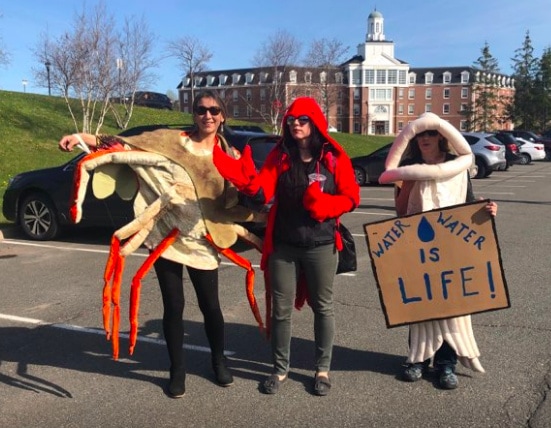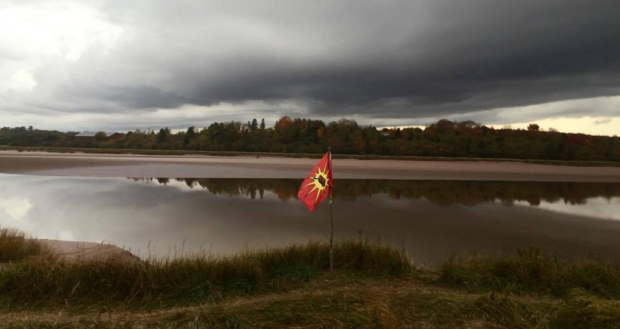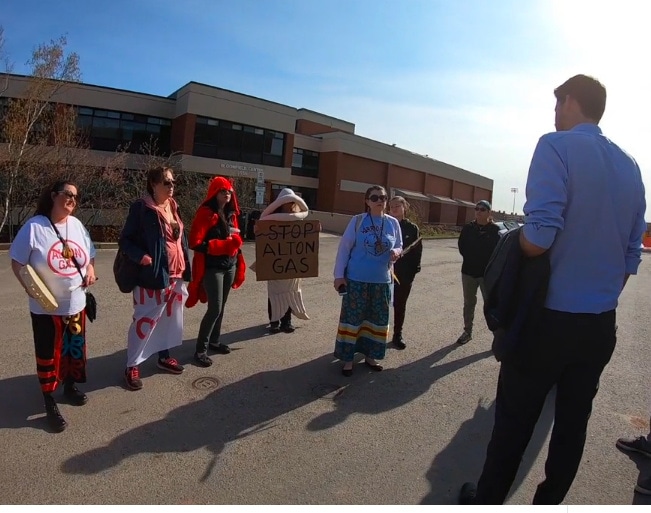Why proposed ECCC regulations for Alton Gas must be stopped

KJIPUKTUK (Halifax) – Back in February, Environment and Climate Change Canada (ECCC) quietly added a notice to their website, announcing their intent to create regulations under the Fisheries Act just for Alton Gas.
That might sound like good news. The proposed Alton Gas project has been controversial at best, the subject of repeated calls for respect, caution and fair process. Mi’kmaq rights holders never consented to this project and have opposed it alongside local residents and environmentalists since they discovered brine pipeline construction in 2014, seven years after the environmental assessment was approved.
But Water Protectors are sounding the alarm, because if these regulations are allowed to happen, they will be the first proposed under the Fisheries Act’s Section 36 prohibition made for one company. Section 36 forbids the deposit of “deleterious substances” into fish-bearing waters- an important prohibition- and these regulations would effectively exempt Alton Gas. In other words, these regulations would allow the company to harm (and even kill) fish in the Sipekne’katik (Shubenacadie) River.
These regulations not only threaten to impact Mi’kmaq treaty rights and the health of the Sipekne’katik River, they could also set a slippery precedent for made-to-order regulations for other projects looking to ignore Indigenous rights, skirt meaningful consultation and put people and the planet at risk.
The project

AltaGas Ltd’s proposed Alton Gas project involves solution mining underground salt caverns, and piping the brine waste through a 12 kilometre pipe into a channel built into the side of the Sipekne’katik River. The idea is that once these caverns are carved out, the company would store imported natural gas in the ground beneath the communities of Alton and Brentwood near Stewiacke, Nova Scotia.
Alton Gas’ models show highly salty brine waste being released directly into a side channel of the Sipekne’katik River every day, the equivalent of up to 3,000 tonnes of hard salt (along with other minerals) over a period of at least two or three years. The science underpinning project approvals has long been criticized as misleading and inadequate, with communities raising significant questions around everything from methane leaks into groundwater to the cumulative impacts of brine waste on the river.
The Sipekne’katik runs through the heart of Nova Scotia in unceded Mi’kma’ki, and is
home to Inner Bay of Fundy salmon – a species at risk- along with Striped bass, American eel and Atlantic sturgeon – all endangered. As Water Protector Michelle Paul describes, the river is also crucial to Mi’kmaq culture, economics and political identity. “The Mi’kmaq have been connected to this river since time immemorial. Historically, it’s served as a superhighway – a lifeline to traverse our vast territory. It’s bounty of more than 50 species of fish, roots and medicines along its banks that have long provided us sustenance.”
A license to kill… fish?
Alton Gas’ environmental assessment documents suggested that no fish would be impacted by Alton Gas’ brine release. At 260 parts per thousand (ppt) the brine waste would be acutely toxic to most fish, with the highest naturally occurring salt concentrations in the river closer to just 28 ppt. However, company models showed no fish passage into the so-called “mixing channel”, and monitoring points were set at the outside edge of the channel.
Water Protectors have long known that these project descriptions don’t add up. For one thing, rights holders were catching fish in the channel. They also noticed that while the provincial assessment included a condition that Nova Scotia Environment (NSE) work with ECCC on a brine release monitoring plan, they could find no evidence that this had happened.
When questions were ignored or downplayed by regulators, Dale Poulette and Rachael Greenland-Smith turned to Freedom of Information requests. Released documents confirmed that ECCC had deemed Alton Gas’ brine release to be deleterious back in 2016, measuring Fisheries Act compliance from the point of release. As Poulette explains, “The province doesn’t have a valid industrial approval without checking off the terms and conditions, one of which is ECCC giving clearance to release their brine into the river. Which they couldn’t do, because their plan doesn’t comply with the Fisheries Act.”
ECCC’s notice of intent describes that “the project is designed to ensure that the salt concentration where the channel rejoins the river would not exceed the highest naturally occurring salt concentrations in the river.” As Greenland-Smith asks, “Will ECCC move the point where they normally measure Fisheries Act compliance to suit Alton Gas, or keep it at the point of release to do their job, which is to protect fish and the people who rely on them?”
What they are calling “consultation“
Despite the gravity of these proposed new rules, it seems that rights holders and concerned citizens must crash political events to be heard. The plan that ECCC has put forward offers only the bare minimum of public engagement. While other changes proposed under the Fisheries Act require pre-consultation documents and public information sessions before draft regulations are published in the Canada Gazette, in this case ECCC has offered no pre-consultation information and only a 30-day comment period.
Earlier this month, East Coast Environmental Law and Ecology Action Centre sent both ECCC Minister Catherine McKenna and the relevant ECCC letters outlining deep concern around the lack of public engagement opportunities related to these proposed regulations. As yet, there has not been a response.
Skimping on consultation here is especially shady, considering that Mi’kmaq governments and rights holders have denounced the lack of meaningful consultation on this project for several years. Nearby Sipekne’katik First Nation took the Nova Scotia Environment and Alton Gas to court in 2016 contesting the sufficiency of the duty to consult, and in 2019 has again filed an appeal on the same grounds. Again, Mi’kmaq rights holders have never consented to this project.
A crab, a lobster and a striped bass walk into a political convention….
It has been abundantly clear that when it comes to Alton Gas, neither provincial or federal governments are heeding the concerns of rights holders, local residents and environmentalists. When Prime Minister Trudeau was approached by Mi’kmaw Water Protector Thunderbird Swooping Down Woman after a political announcement in March, he agreed to meet and hear from the Mi’kmaq Grandmothers protecting the Sipekne’katik River. However, two months later, (and more than three months after ECCC’s notice of intent), Water Protectors, local resident and environmental groups have not been so much as contacted.

This past week, Water Protectors again put the government on notice, confronting Central Nova MP and Secretary to the Minister of ECCC Sean Fraser in fish costumes. When pressed to comment he said, “If it’s not proven that it can be done in a way that is not going to harm fish or fish habitat then it shouldn’t be allowed to go ahead. It has to be done – if it is going to be done – in a way that’s respectful to the marine environment. I know there’s species at risk that live in the river there and I know there are serious concerns raised by the local community.”
But does he mean it? No doubt that Water Protectors will find a way to catch up with Fraser and his ilk soon, possibly with crab, lobster and striped bass in tow. Because the stakes are high. And if enacted, these new regulations would set a dangerous precedent where companies like AltaGas Ltd with millions of dollars to lobby the government can essentially pay for regulations that exempt them from following environmental laws.
As Greenland-Smith notes, “This is an ongoing pattern. Corporations enabled by government get their way regardless of environmental laws and process, Treaty Rights and public opposition. It is up to the people to research and figure out ways to save our precious Earth. The time is now.”
You can support the frontline actions of Water Protectors through the Treaty Truckhouse Legal Fund, and let ECCC know that these proposed regulations are unacceptable by writing to ec.pflp-fpfa.ec@canada.ca, caroline.blais@canada.ca, geoff.mercer@canada.ca, and catherine.mckenna@parl.gc.ca
Sadie Beaton is a settler working at the Ecology Action Centre in unceded Mi’kmaq territroy. A version of this story will be featured in the next issue of EAC’s quarterly publication Ecology + Action
With a special thanks to our generous donors who make publication of the Nova Scotia Advocate possible.
Subscribe to the Nova Scotia Advocate weekly digest and never miss an article again. It’s free!




I think we’re going to have to become more self-sufficient and considerate in Canada. People living in Canada need to be well-informed to be good decision-makers, certainly the Nova Scotia Advocate provides good communication for all. we cannot tolerate marine vessels breaking down in the Bay of Fundy. Ocean-going vessels need to be top of the line before doing business in Canada. We do not want to damage the dulse industry on the Fundy Shores. Dulse is an excellent source of iodine for the deficient population.